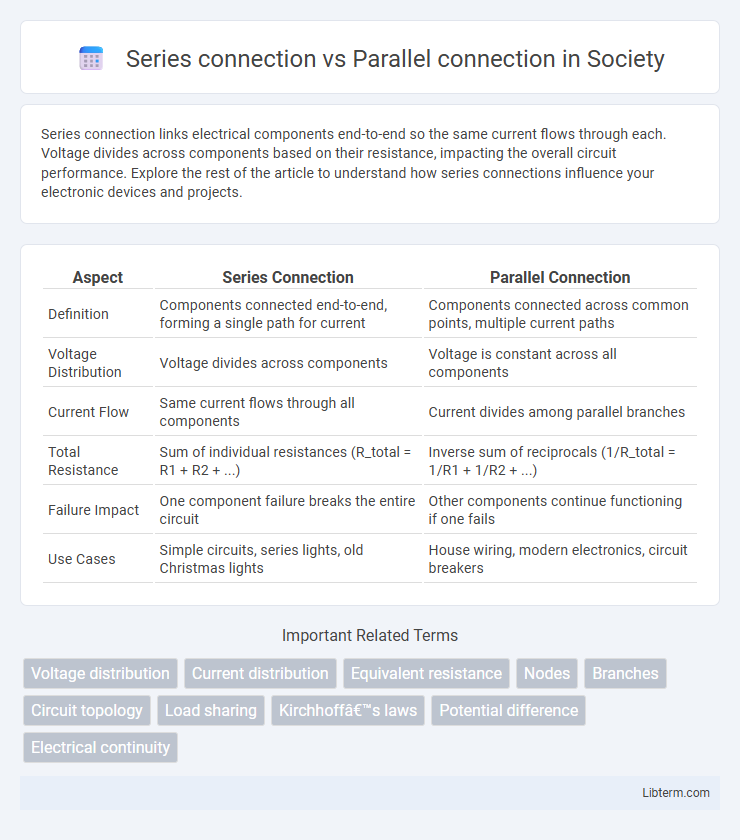Series connection links electrical components end-to-end so the same current flows through each. Voltage divides across components based on their resistance, impacting the overall circuit performance. Explore the rest of the article to understand how series connections influence your electronic devices and projects.
Table of Comparison
| Aspect | Series Connection | Parallel Connection |
|---|---|---|
| Definition | Components connected end-to-end, forming a single path for current | Components connected across common points, multiple current paths |
| Voltage Distribution | Voltage divides across components | Voltage is constant across all components |
| Current Flow | Same current flows through all components | Current divides among parallel branches |
| Total Resistance | Sum of individual resistances (R_total = R1 + R2 + ...) | Inverse sum of reciprocals (1/R_total = 1/R1 + 1/R2 + ...) |
| Failure Impact | One component failure breaks the entire circuit | Other components continue functioning if one fails |
| Use Cases | Simple circuits, series lights, old Christmas lights | House wiring, modern electronics, circuit breakers |
Introduction to Series and Parallel Connections
Series connections link electrical components end-to-end so that the same current flows through each component sequentially, resulting in a total voltage equal to the sum of individual voltages. Parallel connections connect components across the same two points, allowing the voltage across each component to remain constant while the total current is the sum of the currents through each path. Understanding these fundamental configurations is essential for designing circuits that optimize voltage, current, and resistance based on application requirements.
Basic Definitions and Key Differences
Series connection links electrical components end-to-end, creating a single path for current flow, whereas parallel connection connects components across the same voltage source, offering multiple current paths. In series circuits, the total resistance equals the sum of individual resistances, causing the current to remain constant but voltage to divide; parallel circuits feature a total resistance less than any single resistor, maintaining constant voltage while current divides. The fundamental difference lies in current behavior and voltage distribution, influencing circuit design and functionality.
How Series Connections Work
Series connections link electrical components end-to-end, creating a single path for current flow through all devices. Voltage divides across each component according to its resistance, while the current remains constant throughout the circuit. This configuration is commonly used in applications where uniform current is essential, but a break in any component stops the entire circuit.
How Parallel Connections Operate
Parallel connections operate by linking multiple components across the same voltage source, allowing each component to receive the full voltage independently. This configuration ensures that the total current is the sum of the currents through each component, enhancing overall circuit reliability since failure of one component does not interrupt the circuit. Parallel circuits are widely used in household electrical systems to maintain consistent voltage levels and allow devices to operate independently.
Voltage and Current Behavior in Series vs Parallel
In a series connection, the voltage divides across each component while the current remains constant throughout the circuit. Conversely, in a parallel connection, the voltage across each component is equal, but the total current is the sum of the currents through each parallel branch. This fundamental difference affects circuit design, with series circuits favoring consistent current and parallel circuits enabling uniform voltage distribution.
Advantages of Series Connections
Series connections offer the advantage of a uniform current flow through all components, ensuring consistent operation in applications like string lighting or battery packs. They allow for easy voltage addition, where the total voltage is the sum of individual component voltages, beneficial in devices requiring higher voltage levels. Series circuits are simpler to design and troubleshoot, making them ideal for educational purposes and basic electronic applications.
Advantages of Parallel Connections
Parallel connections offer significant advantages, including consistent voltage across all components, ensuring each device operates at its optimal voltage level. This configuration enhances reliability, as failure in one component does not interrupt the entire circuit, allowing the rest to function normally. Parallel circuits also facilitate easier troubleshooting and scalable expansion without affecting overall system performance.
Common Applications for Each Connection
Series connections are commonly used in applications such as Christmas lights and string potentiometers, where the current needs to be the same through all components. Parallel connections are widely employed in household electrical wiring and battery packs for electric vehicles, enabling each device to operate independently with a consistent voltage across components. This distinction allows series circuits to prioritize current uniformity, while parallel circuits ensure voltage stability for multiple loads.
Safety Considerations in Series and Parallel Circuits
Series connections pose safety risks due to increased voltage across each component, which can cause insulation breakdown and overheating if one element fails. Parallel connections offer enhanced safety as each component operates independently, preventing total circuit failure and reducing the risk of electric shock or fire hazards. Proper fusing and circuit breakers are essential in both configurations to mitigate risks like short circuits and overloads, ensuring reliable protection.
Choosing the Right Connection for Your Needs
Series connections provide higher voltage by adding the voltage of each component, ideal for applications requiring increased voltage with a constant current flow. Parallel connections maintain the same voltage while increasing total current capacity, suitable for devices needing consistent voltage but higher current. Selecting the right connection depends on whether your priority is higher voltage or greater current capacity to match your specific electrical requirements.
Series connection Infographic

 libterm.com
libterm.com